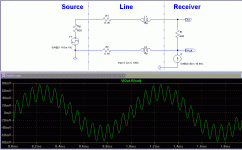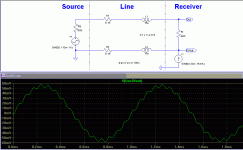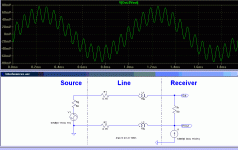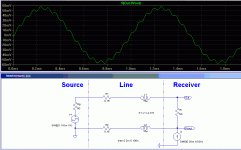I was talking about induction from ground wire current into signal wire.
Here is a typical example: a 1KHz source transmitting the signal to a receiver injecting a 15.6KHz 30mA^ current into the ground.
First picture is the case where the induction between signal and return wires is negligible.
Second picture shows the effect of a strong (0.9) coupling between the wires (equivalent to a tight twisting): some cancellation of the unwanted signal occurs.
It will indeed increase the "absolute" noise voltage on the ground, but at the same time, it will reduce the relative effect of the common mode to differntial conversion, and will ultimately be beneficial (unless there are multiple connections, some not sharing the same ferrite)A ferrite on an unbalanced connection is a bad idea because it will increase the noise induced into the signal line by ground currents. It may help, if the noise from EMI was much greater than that induced by ground currents.
Attachments
Here is a typical example: a 1KHz source transmitting the signal to a receiver injecting a 15.6KHz 30mA^ current into the ground.
[snip]
Elvee,
Revealing! How does this look with Rg=50 ohms?
jan
Thanks. Although I see that you also changed Rr, instead of just Rg.
So, what can we conclude from that?
Is it always a good idea to tightly twist ground- and signal wire with unbalanced connections?
Both from the point of view of minimizing loop area for minimizing RF interference, as well as for minimizing coupling ground ripple & noise (both inductively and capacitively) into the signal wire?
jan
So, what can we conclude from that?
Is it always a good idea to tightly twist ground- and signal wire with unbalanced connections?
Both from the point of view of minimizing loop area for minimizing RF interference, as well as for minimizing coupling ground ripple & noise (both inductively and capacitively) into the signal wire?
jan
Both from the point of view of minimizing loop area for minimizing RF interference, as well as for minimizing coupling ground ripple & noise (both inductively and capacitively) into the signal wire?
I would tend to answer unreservedly "yes", , but we have to careful: as soon as I say it, somebody will come up with some exception I hadn't thought of.
Thus, let's say: in general and most of the time, yes.
I would tend to answer unreservedly "yes", , but we have to careful: as soon as I say it, somebody will come up with some exception I hadn't thought of.
Thus, let's say: in general and most of the time, yes.
I just thought of something else

You lumped the line inductance into two coils L1 and L2.
But there is also a capacitance between the wires.
How about using L-C sections as approximation?
jan
I just thought of something else
You lumped the line inductance into two coils L1 and L2.
But there is also a capacitance between the wires.
How about using L-C sections as approximation?
jan
The effect of capacitive coupling is small for "real" audio situations, but anyway, it will reinforce the effect of the inductive coupling; a bit like the capacitor in a Cuk converter.
If you make C very large in a mental experiment, you see that it will shunt the differential impedance, and therefore reduce the level of interference resulting of the current.
The fact that it is a distributed capacitance changes essentially one thing: it makes the system aperiodic. It would have a low pass behavior for lumped elements.
The effect of capacitive coupling is small for "real" audio situations, but anyway, it will reinforce the effect of the inductive coupling; a bit like the capacitor in a Cuk converter.
If you make C very large in a mental experiment, you see that it will shunt the differential impedance, and therefore reduce the level of interference resulting of the current.
The fact that it is a distributed capacitance changes essentially one thing: it makes the system aperiodic. It would have a low pass behavior for lumped elements.
OK, thanks.
I slowly am getting the idea that if you understand these things you can perhaps manipulate the various elements to make a cable that sounds different from another cable.
Maybe make the cable act low pass or make it very lossy?
I had a personal experience, maybe 20 years ago, of two amplifiers I build, using about 6 inch very heavy, well regarded 'boutique' cable from input RCA to PCB. When listening, I had the idea something wasn't quite right in the soundstage and when measuring there was about 0.5dB gain inbalance above 5kHz in otherwise identical monoblocks.
Turned out that the input cables were very lossy and actually one of them caused 0.5dB more loss at higher frequencies than the other. That was just 6 inch of it...
jan
Last edited:
A system composed of distributed L-C elements cannot act as a low pass, it is flat from 0 to ∞.
In real, lossy cables, there are second order effects causing a √F dependant attenuation, but within the audio range and for cable lengths < hundreds of meters, this effect is absolutely negligible.
Creating a 6 inch cable having a non-flat attenuation for audio is something impossible using normal cable materials, conductors and insulating materials.
To do that, one would need a loaded polymer as an insulator and a highly resistive conductor, like the center one of oscilloscope probes cables.
What is possible though is that the cable construction has such a high capacitance that it forms a low-pass filter with the source resistance.
But transmission line effects at audio frequencies are impossible with small lengths, and even with long runs, they remain marginal.
The lumped capacitance can have an effect on high impedance systems, and the lumped inductance can have an effect on low impedance systems (speakers), but as a pure transmission medium, the cable is flat.
In real, lossy cables, there are second order effects causing a √F dependant attenuation, but within the audio range and for cable lengths < hundreds of meters, this effect is absolutely negligible.
Creating a 6 inch cable having a non-flat attenuation for audio is something impossible using normal cable materials, conductors and insulating materials.
To do that, one would need a loaded polymer as an insulator and a highly resistive conductor, like the center one of oscilloscope probes cables.
What is possible though is that the cable construction has such a high capacitance that it forms a low-pass filter with the source resistance.
But transmission line effects at audio frequencies are impossible with small lengths, and even with long runs, they remain marginal.
The lumped capacitance can have an effect on high impedance systems, and the lumped inductance can have an effect on low impedance systems (speakers), but as a pure transmission medium, the cable is flat.
[snip]Creating a 6 inch cable having a non-flat attenuation for audio is something impossible using normal cable materials, conductors and insulating materials.
To do that, one would need a loaded polymer as an insulator and a highly resistive conductor, like the center one of oscilloscope probes cables.
[snip].
Not remembering all the dirty details, I think we concluded it was the insulating material.
jan
- Status
- This old topic is closed. If you want to reopen this topic, contact a moderator using the "Report Post" button.
- Home
- Amplifiers
- Power Supplies
- Jan's quizz in the February Newsletter



